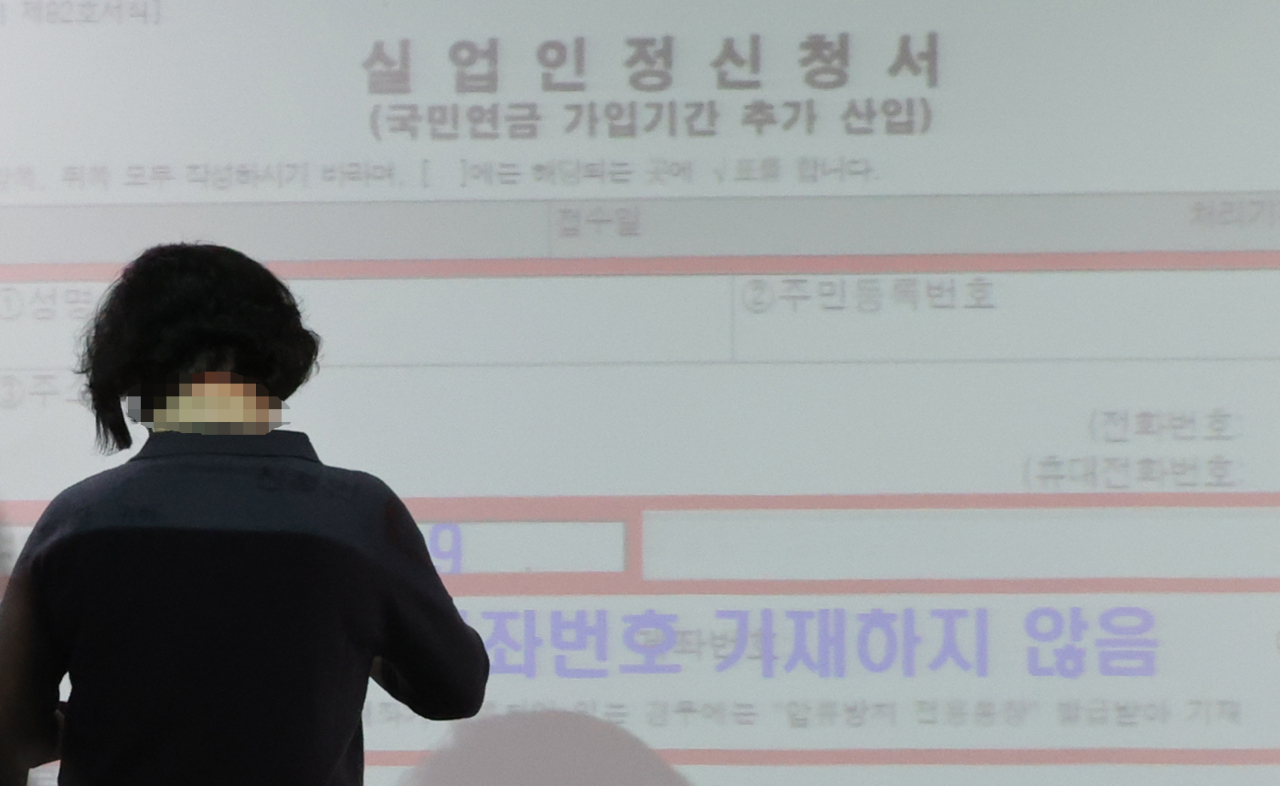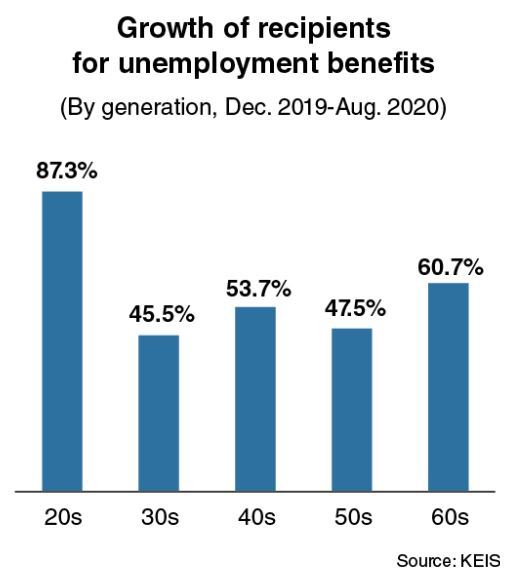
This photo shows an applicant for unemployment benefits at a regional office of the Employment and Welfare Plus Center in Seoul earlier this year. (Yonhap)
SEJONG -- The number of recipients of unemployment benefits in South Korea saw the sharpest increase among people in their 20s this year.
According to the Korea Employment Information Service, the number of recipients came to 711,471 in August, up 56.4 percent from 454,630 in December 2019. The first case of the novel coronavirus in Korea was reported in January 2020.
Among people receiving benefits, people aged 20-29 were the fastest-growing demographic, showing an 87.3 percent increase over the corresponding period from 58,257 to 109,133. For women in their 20s the trend was even stronger, with their numbers growing from 34,163 to 66,998 for an increase of 96.1 percent.
“Young workers with short careers had been initially pressured to quit since the epidemic began hitting the nation in February,” said a tourism industry employee.
People in their 60s were next: The number of recipients in this age group increased by 60.7 percent, from 97,540 in December 2019 to 156,775 in August 2020.

(Graphic by Kim Sun-young/The Korea Herald)
Given that the retirement age is 60 for most jobs, a large proportion of recipients aged between 60 and 69 are believed to have been contract employees or self-employed businesspeople before they lost their jobs.
Those in their 40s ranked third with 53.7 percent growth from 87,976 to 135,229, followed by those in their 50s with 47.5 percent and those in their 30s with 45.5 percent.
In all age groups, women outstripped men in both number and growth with an 11-percentage-point gap. The number of women on unemployment benefits increased by 72.7 percent (from 212,780 to 367,566) vs. 61.7 percent for men (from 212,610 to 343,905).
People who had been self-employed outpaced salaried peopled by 79 percent vs. 67.2 percent.
The KEIS data also showed that Ulsan posted the highest growth, 81 percent, in the number of benefit recipients among the nation’s eight major cities.
Incheon and Seoul ranked second and third with 72.4 percent and 71.6 percent. Daegu was placed at No. 4 with 66.4 percent, followed by Daejeon with 66.3 percent, Gwangju with 64.5 percent, Sejong with 62.1 percent and Busan with 59.8 percent.
Ulsan is a manufacturing-oriented city, while a dominant portion of tourism and airline-related businesses operate in Seoul or Incheon.
Among the nation’s 17 major areas, including the eight cities, Jeju Province was second to none. Its tally of recipients surged by 128.2 percent over the same period, from 4,403 to 10,052.
Many Koreans are choosing Jeju, the nation’s largest island, as a preferred tourist destination amid the epidemic. But the damage from the lower number of inbound tourists remains significant.
COVID-19 has dealt a severe blow to self-employed businesspeople on the island, such as those running coffee shops, as well as those in the tourism industry.
The virus aggravated worries over fiscal soundness as the government’s benefit payouts have increased rapidly over the past decade.
In the early and mid-2010s, yearly payouts for jobless people ranged between 3.3 trillion won ($2.7 billion) and 4.5 trillion won.
The figure recorded 4.67 trillion won in 2016 during the previous administration amid moderate growth in the volume of unemployment benefits.
The volume of unemployment benefits has increased sharply over the past three years, reaching 5 trillion won in 2017, 6.43 trillion won in 2018 and a record high of 8.07 trillion won in 2019.
Market watchers estimate the figure will hover between 11 trillion won and 12 trillion won in 2020.
By Kim Yon-se (
kys@heraldcorp.com)







![[Graphic News] More Koreans say they plan long-distance trips this year](http://res.heraldm.com/phpwas/restmb_idxmake.php?idx=645&simg=/content/image/2024/04/17/20240417050828_0.gif&u=)